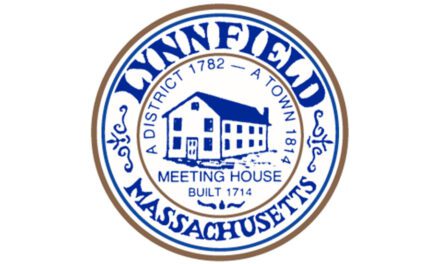Published November 6, 2019
By DAN TOMASELLO
LYNNFIELD — Two dozen parents were given a crash course about the world of vaping during an Oct. 29 presentation in the Al Merritt Center.
A Healthy Lynnfield sponsored the presentation. Substance Abuse Prevention Coordinator Peg Sallade recalled that she previously worked with the Massachusetts Department of Public Health’s Tobacco Control Program in the mid-1990s when the state “was going smoke-free in restaurants and bars.”
“We have come a long way since then because not a lot of people smoke anymore,” said Sallade. “We have really reduced the rates of young people smoking across the nation. But now we have a new problem. The face changes, but the industry does not.”
Northeast Tobacco-Free Community Partnership Program Manager Ashley Hall agreed.
“We know that vaping is an issue and we need to address it,” said Hall.
How vaping works
Hall began the presentation by giving an overview of different vaping products such as Blu, Juul and Riptide. She also explained how they work.
Vaping products include a battery as well as an atomizer, which Hall said is “what heats up the e-liquid.” She said the cartridge is where the e-liquid is stored. In addition to nicotine, Hall said e-cigarettes’ cartridges contain propylene glycol, glycerin, flavorings and other chemicals.
“E-liquids or juices are the stuff that people are inhaling,” said Hall. “They come in thousands of flavors. It’s not just food flavorings and water.”
Hall said a vape pen and an e-cigarette are the same thing. She said there is a misconception that vape cartridges contain water.
“It’s an aerosol,” said Hall. “It’s not water vapor. It’s not harmless whatsoever. It’s an electronic way to deliver nicotine to your body.”
Hall said a number of vaping products’ packages resemble candy boxes. She said the different vaping flavors are the reason why young people are getting addicted.
“You can eat strawberries all day long because they are good for you,” said Hall. “But don’t inhale it into your lungs.”
Hall said the smell from e-cigarettes differs than traditional cigarettes.
“It’s a subtle, sweet scent,” said Hall. “That is why teens are getting away with it. It can smell like perfume, a drink or ChapStick.”
Hall said Juul pods are “pre-loaded” and are “easy to hide.” She said one Juul pod is equivalent to a pack of cigarettes.
“There is an absurd amount of nicotine in these and kids don’t realize it,” said Hall.
Hall said vape cartridges containing marijuana have a darker, yellow liquid compared to nicotine cartridges.
“It looks like honey,” said Hall.
Hall said vape pens get charged with a computer or a wall outlet because it’s an USB-connected device.
“They look just like a flash drive,” said Hall.
Health concerns
In addition to giving an overview about how different vaping products work, Hall outlined the various health problems associated with vaping.
Hall said the recent outbreak of vaping-related illnesses across the country has caused 1,888 people to get sick in 49 states, Washington, D.C. and one U.S. territory. According to the Centers for Disease Control and Prevention, there have been 37 deaths associated from the lung illness, including two in Massachusetts.
Gov. Charlie Baker’s temporary vaping ban was originally set to expire in January until a judge recently ruled the ban will expire on Christmas Eve.
“The goal of the ban was to slow down the number of cases because there were so many being reported,” said Hall. “The CDC had barely enough time to investigate it, so Massachusetts decided to help bring down the rapid increase of cases so they could look at them and figure it out.”
Hall said, “There has not been an identified substance linked to the cases.” She said the illnesses have been associated with both nicotine and marijuana vaping.
“That is why Gov. Baker’s ban was on all vaping products,” said Hall. “You can put anything in them. The only thing we should be putting into our lungs is air.”
While Hall said she supports the temporary vaping ban, she is concerned about people experiencing withdrawal systems since they cannot smoke e-cigarettes. She said the withdrawal symptoms include anxiousness, depression, headaches, increased sweating and craving e-cigarettes.
In response to a question from a woman in the audience, Hall said the vaping ban applies to online sales as well as stores.
Hall said vaping cartridges contain diacetyl as well.
“Flavored popcorn used to have diacetyl in it,” said Hall. “The factory workers were inhaling the diacetyl from the flavored popcorn and they all got bronchiolitis. It’s a lung disease that was nicknamed popcorn lung. And now we are seeing the same problems in teens. That factory was shut down and that type of production was shut down. But now tobacco companies are putting it in sleek little pods and are having kids inhale it.”
Hall noted a recent study revealed that laboratory mice exposed to e-cigarette smoke “started to show signs of bladder cancer.”
“We know that e-cigarettes contain cancer-causing chemicals and even heavy metals such as nickel, tin and lead,” said Hall.
Hall also said nicotine negatively impacts the development of teenagers and young adults.
“We know that the brain is not fully developed until the age of 25,” said Hall. “The earlier they start, the more likely they will become addicted and they will have a harder time quitting.”
Hall said vape product labels try to hide the fact that e-cigarettes contain nicotine.
“The FDA has the authority to regulate the manufacture, import, packaging, labeling, advertising, promotion, sale and distribution of all of this stuff,” said Hall. “They have not used it. That is where the issue lies because if they did, things like this wouldn’t happen. They have delayed their regulatory authority when thousands of people are sick and people are dying.”
In response to a question from a parent, Hall said, “The draw for kids vaping can be summed up in three words.”
“Sweet, cheap and easy to get,” said Hall. “Once our youth learned that cigarettes cause cancer and deaths, the tobacco industry realized they were going to start losing money. They decided to hook a new generation by making it look like a flash drive and making it taste like bubble gum or a fruit smoothie.”
How to fight vaping
Hall and Sallade gave the parents several tips in order to prevent adolescents from vaping.
Sallade told the parents in attendance that they “have a right to go through their kids’ room” in order to see if their children are vaping. She also encouraged parents to monitor their children’s internet and social media use.
Hall noted that a number of adolescents have purchased vaping products online with Visa gift cards. She said having vaping products easily accessible in stores increases adolescent use.
“We know the more that these companies advertise, the more kids will use them,” said Hall.
Hall recalled that flavored cigarettes with the exception of menthol, mint and wintergreen were banned in 2009.
“Mint, menthol and wintergreen are the only flavored combustible cigarettes still legally available in the United States,” said Hall. “The reason why mint, menthol and wintergreen are also harmful for people’s health is because they are a cooling agent. We know that smoking is harsh on your throat, your lungs and your respiratory tract, so adding menthol is a cooling agent just like cough drops, IcyHot and Vicks VaporRub. It masks the true harsh affects of these cigarettes, making it easier to start and harder to quit.”
Hall noted a number of cities and towns have established “flavor restrictions,” which mandate that flavored e-cigarettes can only be purchased by people age 21 and older in adult retail tobacco stores.
“But these flavor restrictions do not include mint, menthol and wintergreen because they were not included in the 2009 regulations,” said Hall.
Hall said, “The big push right now is to include mint, menthol and wintergreen in the flavor restrictions.” She said the North Andover Board of Health recently voted to prohibit the sale of the three flavors.
“The state is looking at a flavor ban for all tobacco products, which would include mint, menthol and wintergreen,” said Hall. “But until that passes, we need to focus on the local level just in case that bill doesn’t pass.”
When parents are talking to their children about vaping, Hall encouraged parents to “use their language.”
“Don’t ask them if they are using electronic nicotine delivery systems,” said Hall. “They will probably say no. But if you ask them if they have a Juul or a vape, they might say yes. Those two words are synonyms. What you are inhaling might be a little bit different, but you are still smoking.”
Hall said there are two different ways the town can fight vaping.
“The biggest regulation Lynnfield is missing as far as fighting tobacco is capping the number of retailers selling tobacco,” said Hall. “The town has flavor restrictions so you can’t buy flavored products in regular stores, but that doesn’t include mint, menthol and wintergreen. Those are the two biggest policy pushes that should be focused on in Lynnfield.”




